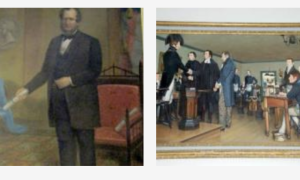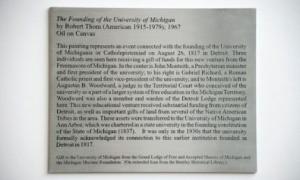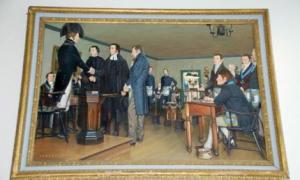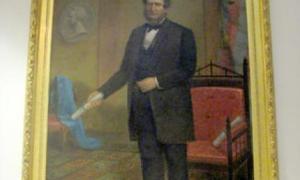Henry Philip Tappan Portrait
Henry Philip Tappan was the first president of the University of Michigan. He became president in 1852 and served until 1863. Tappan brought to Michigan a new way of looking at higher education, which deviated from the standard classical literary course that was commonly presented. Tappan brought with him ideals of the Prussian system of education, which combined the classical courses with basic and applied scientific courses, and along with that brought a focus on research. Proper facilities for research were a priority for Tappan. A combination of the Detroit Observatory, built in 1854, the Chemical Laboratory, built in 1856 and the already existing Medical School, brought together classical and scientific study in one location.
It is only natural that the Tappan painting found its new home in Palmer Commons, one part of the Life Sciences Complex, a twenty-first century addition that embodies the U of M's continuing role as a leading research university. The painting, which measures 9'9" tall by 6'9" wide, is by noted American painter Alvah Bradish. It was painted around 1860 when Tappan was president. It was restored in 2005 by the History & Traditions Committee and graciously loaned Palmer Commons from the Bentley Historical Library.
The Founding of the University of Michigan
By Robert Thom (American, 1915-1979); 1967; Oil on Canvas
This painting represents an event connected with the founding of the University of Michigania or Catholepistemiad on August 26, 1817 in Detroit. Three individuals are seen here receiving a gift of funds for this new venture from the Freemasons of Michigan. In the center is John Monteith, a Presbyterian minister and first president of the university; to his right is Gabriel Richard, a Roman Catholic priest and vice-president of the university; and to Monteith's left is Augustus B. Woodward, a judge in the Territorial Court who conceived of the university as part of a larger system of free education in the Michigan Territory. Woodward was also a member and warden of the Detroit Lodge represented here. This new educational venture received substantial funding from citizens of Detroit, as well as important gifts of land from several of the Native American Tribes in the area. These assets were transferred to the University of Michigan in Ann Arbor, which was chartered as a state university in the founding constitution of the Sate of Michigan (1837). It was only in 1930s that the university formally acknowledged its connection to this earlier institution founded in Detroit in 1817.




